Trondheim, Honningsvåg,
Brønnøysund, Hammerfest, Norway
Walking into the town from the pierhead, the first lettering example
encountered (and the only one we found of this kind – Trondheim is a
well-cleaned place) was a piece of trade lettering on a gable end.
3 Carl Johans Gate
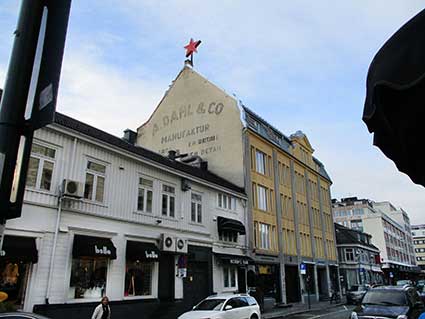
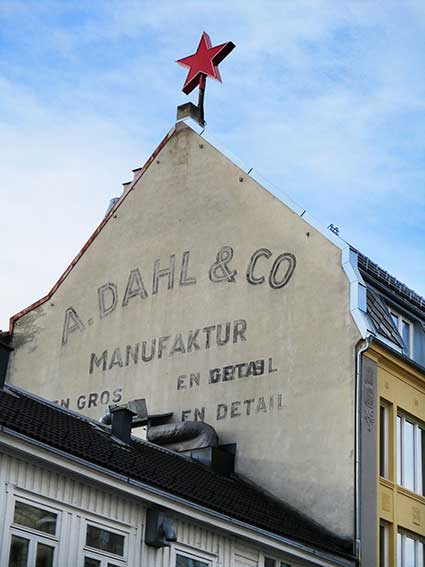 2020 images
2020 images
A. Dahl & Co. was originally founded in 1873 by Anders P.
Dahl (1845-1908) manufacturing all sorts of goods for ladies and
gentlemen. It also had an equipment and leather goods department and a
tailor's workshop for women's and men's clothing. It's not clear
whether the company is still in business.
Søndre gate/Carl Johans Gate
Below: An eyecatcher on the corner with Carl Johans Gate.

Further along Søndre gate, on the crossroads with Olav
Tryggvason Gate, stands another eye-catcher of a corner building
with highly decorative dome and the monogram 'MJ' or 'JM' appearing
twice.
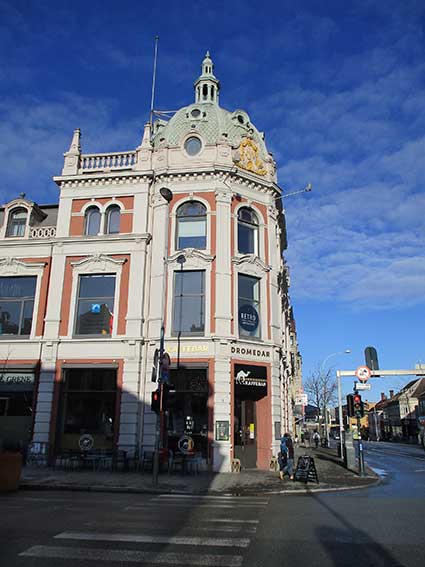
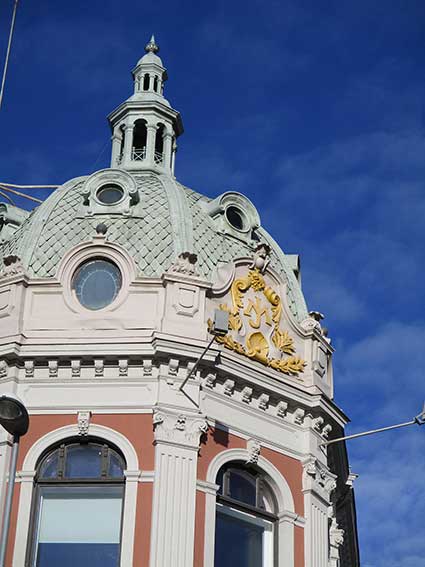
13-15 Søndre gate
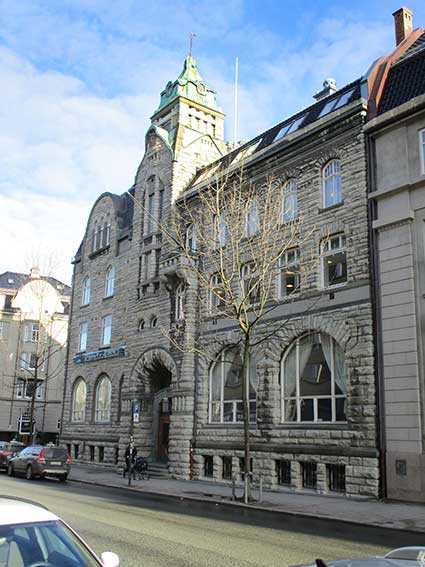
This run of buildings, continuing round the corner into Kongens
gate,
is currently the Norway headquarters of the Danish banking house,
Danske Bank. Number
13 is the most decorative with its 'Nordic Art Nouveau' facade of
rusticated stonework and arched entrance and windows.
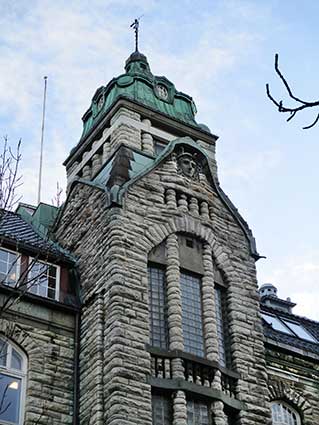
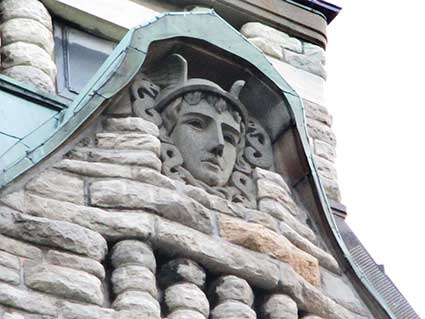
High on the facade, the street is looked over by the head of the
Roman god Mercury surrounded by snakes. Mercury has essentially the
same aspects as Hermes, wearing winged shoes (talaria) and a winged hat
(petasos), and carrying the caduceus, a herald's staff with two
entwined snakes that was Apollo's gift to Hermes. He is
the god of financial gain, commerce, eloquence, messages, communication
(including divination), travelers, boundaries, luck, trickery and
thieves; he also serves as the guide of souls to the underworld.
Reading that roster, one wonders if the architect, presumably
originally working for a banking client, had a sense of humour.
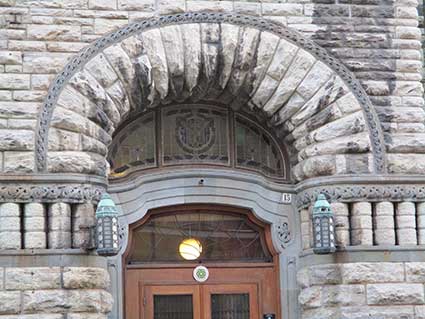
Below: the decorative monogram
built
into the stonework of the arch '14' indicates that this area was
renumbered.
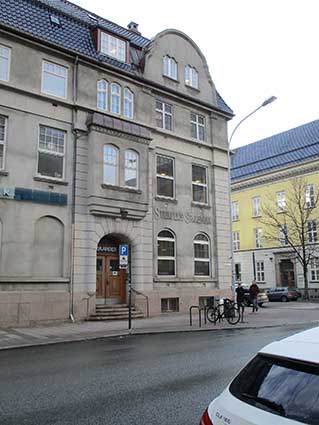
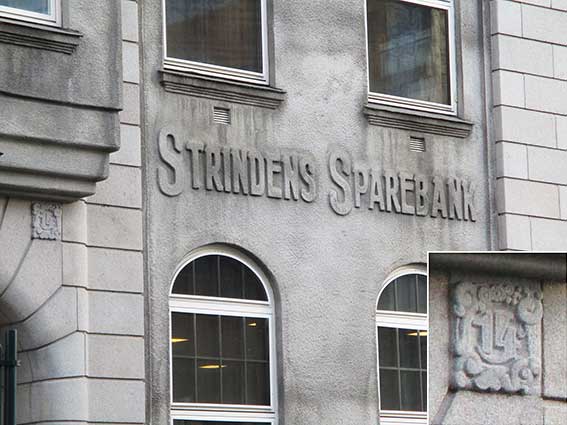
'STRINDENS SPAREBANK'
The condensed 'large and small' capitals here have dropped
capital 'S's. 'Sparebank' means savings bank in Norwegian. Established
in 1842, Strindens eventually merged with other savings banks in 1975.
19 Kongens gate
Below: a highly decorated palladian facade on the School of
music in Kongens
gate. One cherub plays a flute, the other a lute.
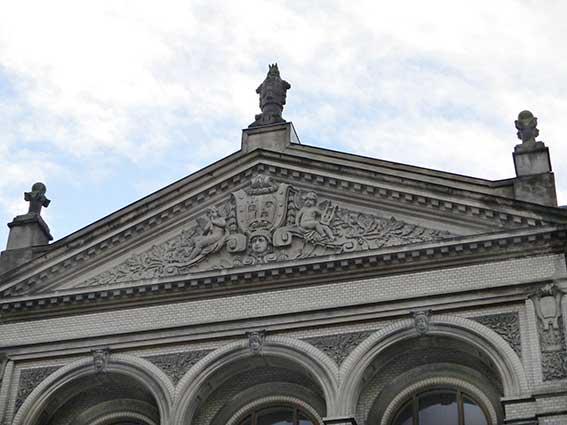

The Arve Tellefsen sculpture at the lower right of the general
view celebrates the Trondheim-born violinist (born 1936).
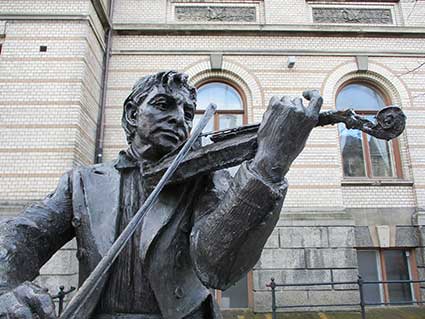
Vår Frue (Our Lady) Church on Kongens
gate
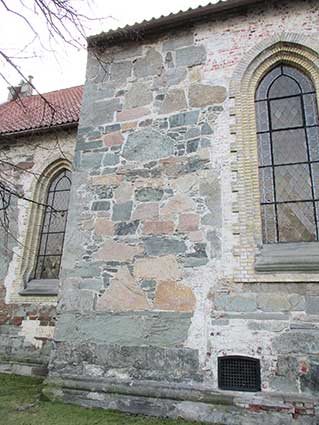
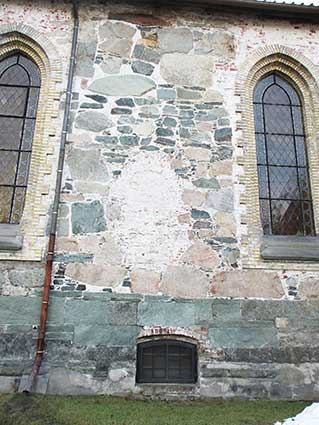
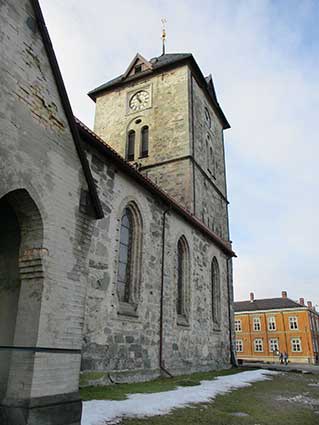
The elevation on the Kongens gate is a patchwork of polychrome
stonework, speaking of ages of history. This, the
eastern part, is identical to the original medieval church which dates
from the late 12th century. The exterior had been
plastered and painted white, but this was removed to reveal its
original medieval state.
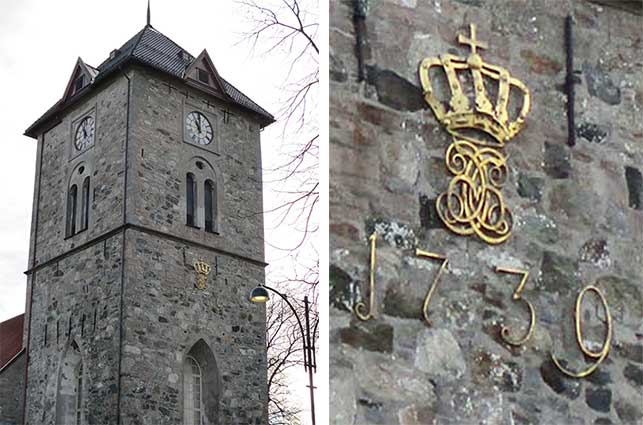
The tower bears a clock on every face and the west elevation
features a golden crown and royal monogram with the date '1739'
all in gold metal.
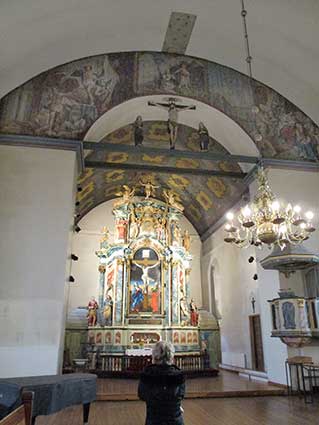
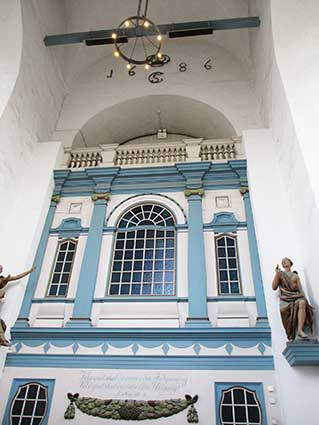
However, the typically Catholic (more correctly the Lutheran
Church of Norway) interior, forward of a large café area, with much
carving, gilding and painted iconography – and within the 'entrance
hall' is the date '1686' in wrought iron. The
two dates on the tower relate to its much later building and rebuilding
than the original nave and chancel.
City Square
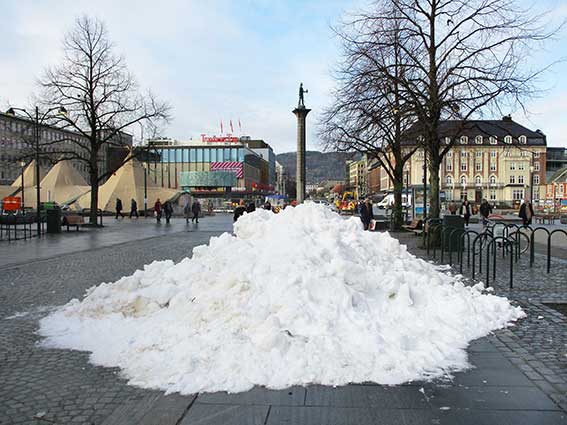
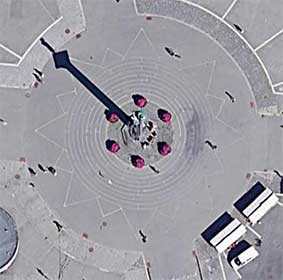 Aerial view
Aerial view
The work of sculptor Wilhelm Rasmussen (1879-1965), this staue
honours King
Olav Tryggvason who was the city's founder. The 18 metre (58 foot) high
statue is mounted on top of an obelisk. It stands at the centre of the
city square (Torvet i Trondheim) at the intersection of the two main
streets, Munkegata and Kongens gate. The statue was unveiled in 1921.
Around the base is a cobblestone mosaic, dating from 1930, which
forms a gigantic sun dial with the column as its gnomon. The sun dial
is calibrated to UTC
(Coordinated Universal Time)+1, meaning that the reading is inaccurate
by one hour in the summer.
This city, as one might expect in Norway, is very clean: little
litter, chewing gum or cigarette butts in the street; even the snow is
ploughed into
a neat pile.
Nidaros Cathedral
It would be remiss not to acknowledge the nearby Nidaros
Cathedral: a cathedral of the Church of
Norway. 'Nidaros' is the medieval name of Trondheim when
it was the
capital of Norway's first Christian kings. It is
built over the burial site of King Olav II (c. 995-1030, reigned
1015-1028), who became the patron saint of the nation. It is the
traditional location for the consecration of new kings of Norway. It
was built over a 230 year period, from 1070 to 1300 when it was
substantially completed. However additional work, additions and
renovations have continued intermittently since then; the most recent
changes were completed in 2001. Nidaros was designated as the cathedral
for the Diocese of Nidaros in 1152. After experiencing the turmoil and
controversies of the Protestant Reformation of the 16th century, it was
taken from the Catholic Church by the newly established state Church of
Norway in 1537, which adopted the teachings and reforms of Martin
Luther, Phillip Melancthon and others, becoming an Evangelical Lutheran
church. Nidaros is the northernmost medieval cathedral in the world.

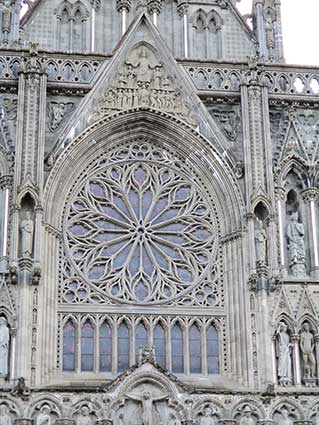
The restoration of the West Front took from 1905 to 1983 and was worked
on by a large number of sculptors. This medieval gothic
extravaganza is therefore modern.
Street furniture
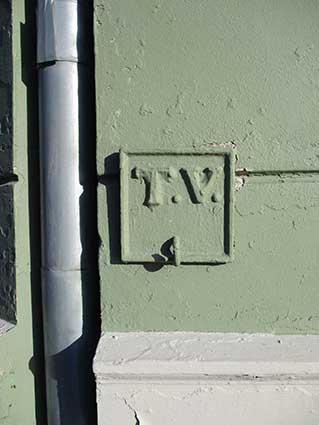
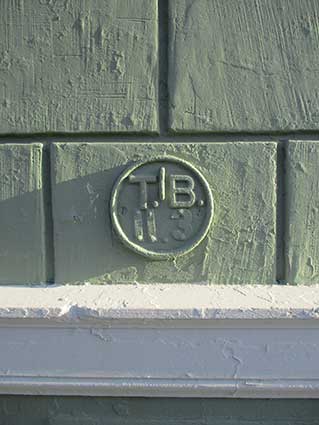
These two plates probably indicate water hydrants.
Trondheim goes in for very chunkily cast manhole covers. The one
on the left (and that below it) depict a man of religion on the left
and a king on the right with the scales of justice between them; three
faces appear below. The top version is cast by
'FURNES';
the lower is by 'ULEFOS'.
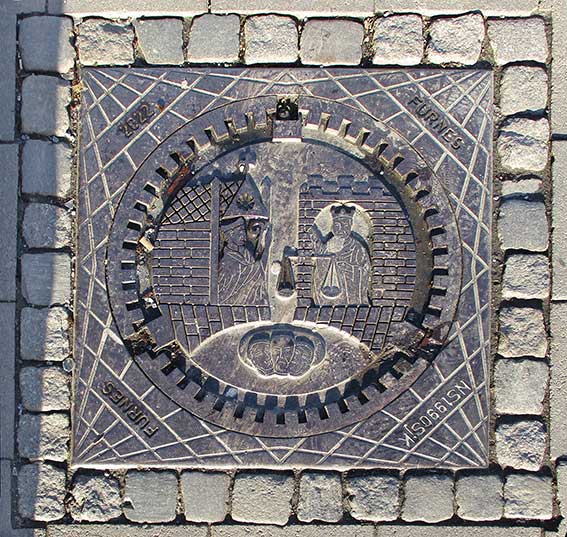
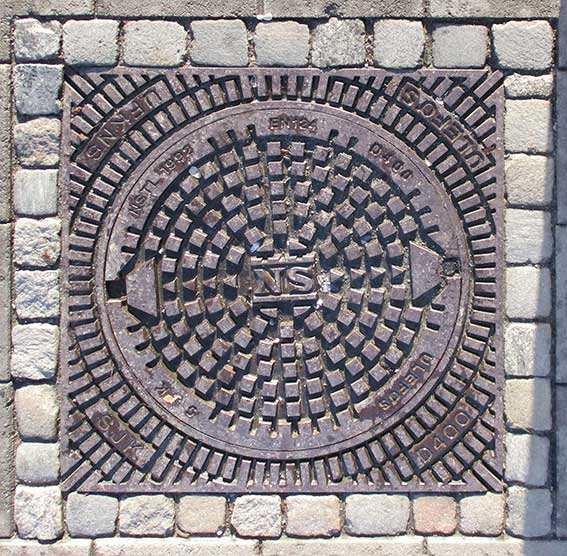
The manhole cover above right certainly does its best to avoid
pedestrians slipping on the ice which frequently forms on the pavements
and metal covers. The casting is by 'ULEFOS'.
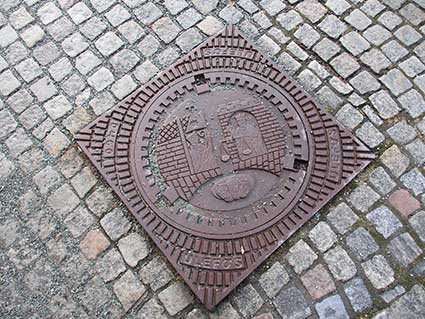
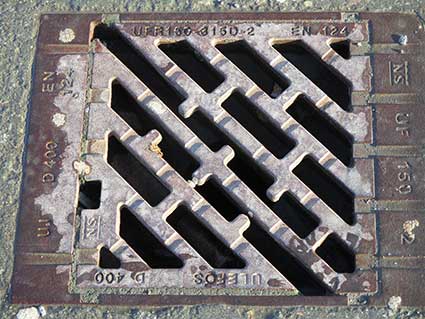
The city certainly makes full use of the local stone setts on
its pedestrian areas. Above right, another product by
'ULEFOS': a drainage cover in a cast iron surround, the whole covered
in code lettering.
Britannia Hotel, Dronningens
gate 5
This one was something of a surprise – a luxury hotel in Norway
called 'The Britannia'. However, the links between the United Kingdom
and Norway go back much further than the close ties of the Second
World War (when the Nazis laid waste to much of the country and
many Norwegians died). Vikings from Norway formed an important part of
Britain's history and Anglo-Saxons of Britain knew and travelled to the
Kingdom of Norway in the ninth century.
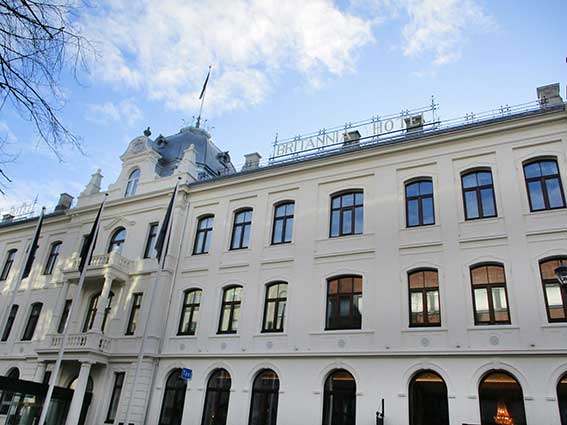
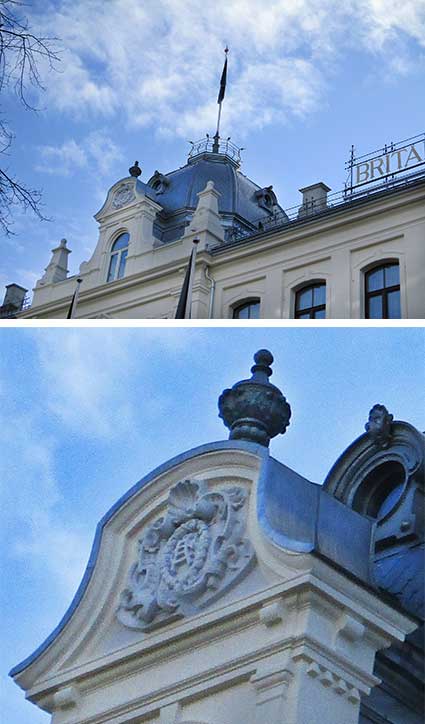
Very high on the pediment in front of the dome is a monogram
'AC' or 'CA'.
The old Post Office
(Hovedpostkontoret, aka Posthuset), Dronningens gate 10
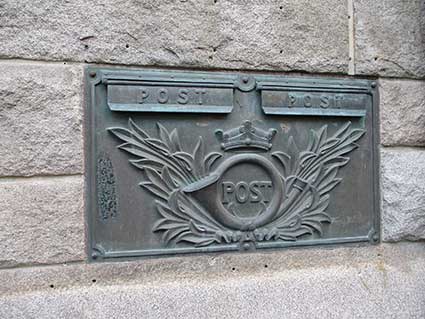
The letter-boxes are named thrice: 'POST'.
The building has been formally closed to the public since the
postal service terminated its operations there back in 2013 and moved
office to
the basement beneath a Burger
King and a glassware shop.
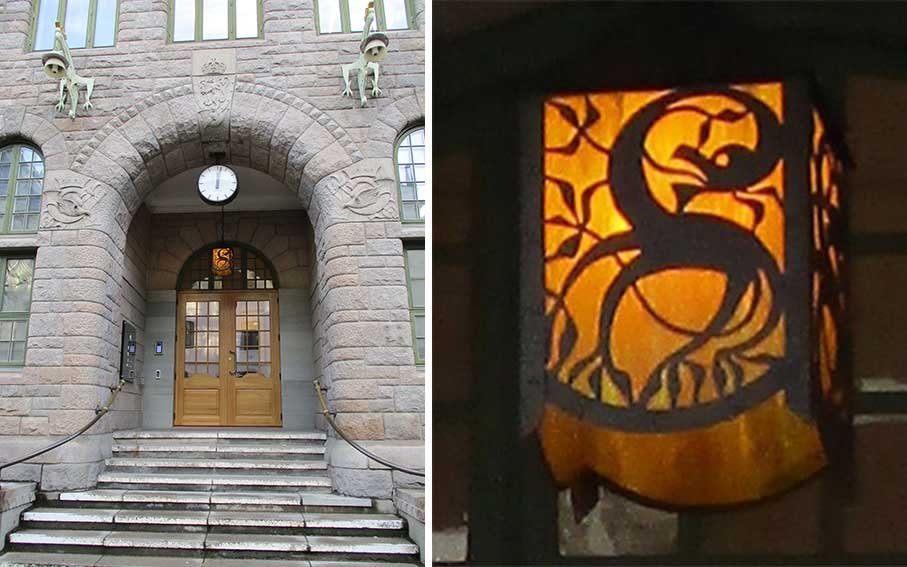
This monumental and imposing edifice was one of Karl Norum‘s
last
masterpieces before he died in 1911. He designed six
buildings of Jugendstil style in Trondheim, but those are some of the
most famous and most beautiful buildings in town. Art
Nouveau was named in Belgium and flourished in Paris; in Germany and
Scandinavia, it was called Reformstil ('Reform style'), or Jugendstil
('Youth style'), after the popular German art magazine of that name.
The coastal town of Ålesund is famous as an Art Nouveau town because of
the concentration of what we might call 'Nordic Art Nouveau'
architecture
(perhaps a more austere variation of the style compared to the sinuous
whiplash
style of French Art Nouveau architecture). While not underestimating
the fine display of such buildings in Ålesund
(saved almost by chance from demolition in modern times, but now
celebrated), in fact Trondheim has numerically even more of this style
of building; however, they are more scattered around the city.
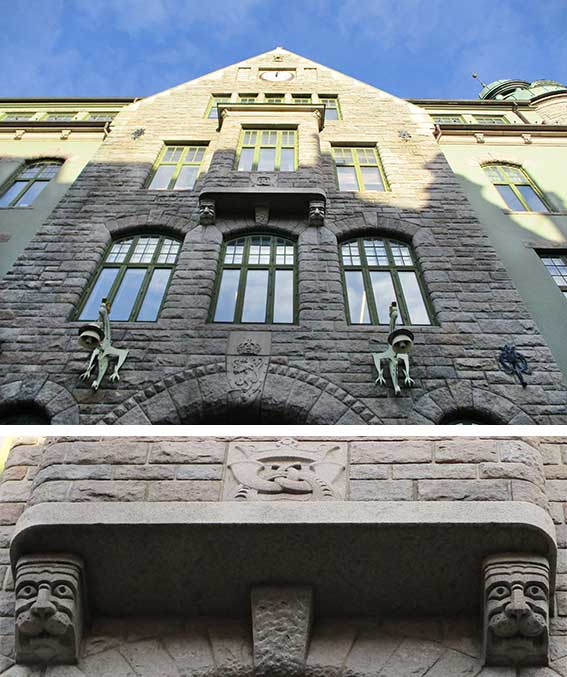
The grotesque, but endearing, corbels beneath the projecting window
also carry the postal service crest.
The metalwork, crowned 'angry birds' holding the lamps mark this
exterior out.
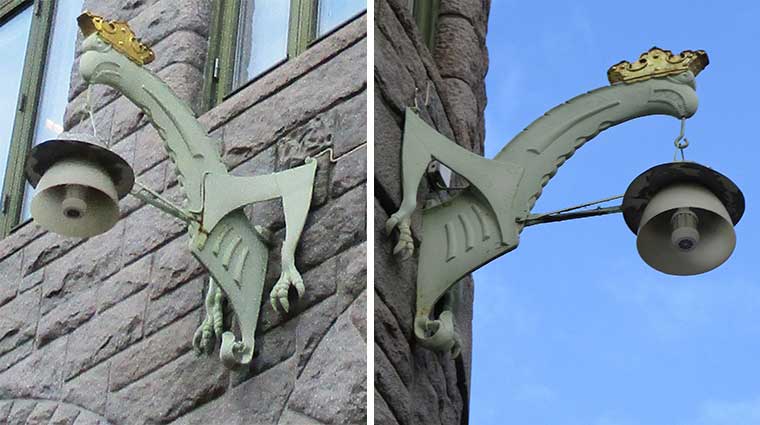
While we're visiting coastal Norway, let's look at some other
lettering examples including a couple of typical village/town churches
with dated weather-vanes.
Honningsvåg church
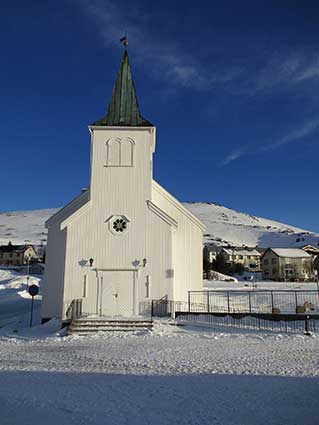
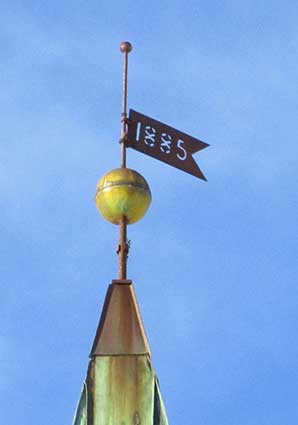
This, perhaps, rather humble-looking church has a rather more
fancy pinnacle than that below (although the latter's architecture is
more sophisticated). The weather vane is pierced to form the date '1885'.
Brønnøysund church
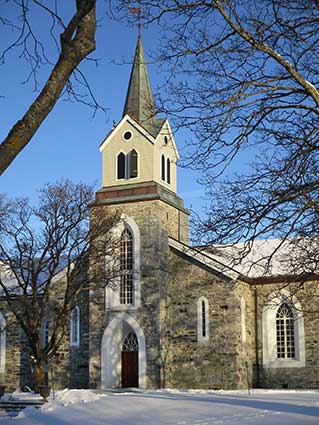

Another pierced weather vane, here dated '1870'.
See also some similar examples of dated
weather-vanes in Ipswich.
The Meridian monument,
Fuglenes, Hammerfest
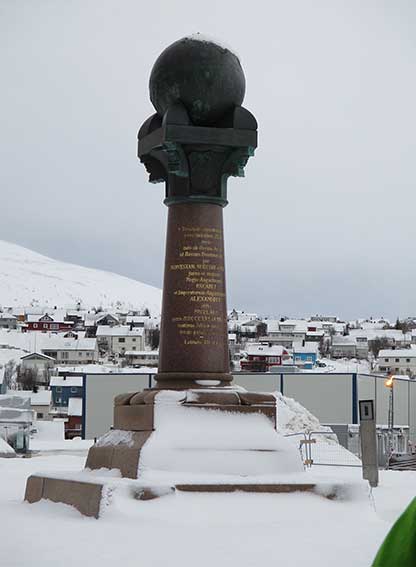
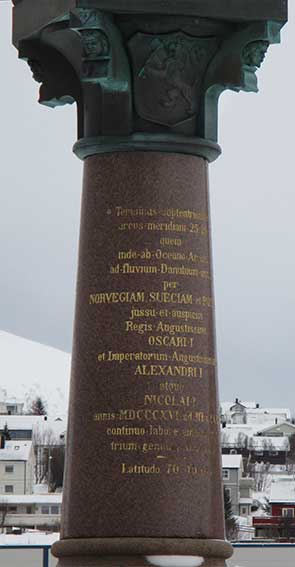
The meridian column on Fuglenes in Hammerfest is a modest
monument to one of the biggest scientific tasks in the world: that of
measuring the planet itself. It marks the start of a 2,820 kilometer
arc that ends in the Black Sea.
Friedrich Georg Wilhelm von Struve (1793–1864), the German geophysicist
who was the director of the stellar observatory at the University of
Dorpat in Russia (now Tartu in Estonia) began work on mapping the exact
shape and size of the planet in 1816. In his work, von Struve used 265
measurement points – triangulation points – that form a 2,820
kilometer-long arc from Finnmark to the Danube Delta.
How is the planet measured? By putting so many measurement points along
a meridian (the vertical lines on a map) it was possible to calculate
the exact size and shape of the planet, which allowed cartographers to
create more accurate maps. The project thus represented a giant
scientific leap forward and was also an early example of scientific
collaboration across national borders. Struve’s meridian belt crosses
10 countries. In 2005, 34 of the triangulation points – the ones that
are distinguished by a landmark – became protected and included as
cultural memorials on the UNESCO world heritage list. In the 1800s, the
project involved two countries: Russia and Sweden/Norway. Today,
Struve’s Geodetic Arc spans ten countries: Norway, Sweden, Finland,
Russia, Estonia, Latvia, Lithuania, Belarus, Moldova and Ukraine.
Hammerfest is the most northerly town in the world – and, at that time,
the most northerly place in the world that scientists could reasonably
travel to – and it marks the north end of the arc. It was here that the
Meridian Column was erected in 1854, inscribed with the following text
(in translation):
‘The northernmost end of a geodetic arc at 25° 20′ from the
northern ocean to the Danube river – through Norway, Sweden and Russia.
On the instructions of HM Oscar I and Emperors Alexander I and Nicolaus
I, using unbroken geometries. Latitude: 70° 40′ 11.3″.’
Ironically, Friedrich Georg Wilhelm von Struve is not mentioned on the
column. It was ever thus.
Home
Return
to Historic Lettering from outside
Ipswich
Please email any comments and contributions by clicking here
Search Ipswich
Historic Lettering
©2004 Copyright
throughout the Ipswich
Historic Lettering website: Borin Van Loon
No reproduction of text or images without express
written permission

 2020 images
2020 images


















 Aerial view
Aerial view


















